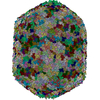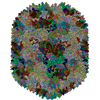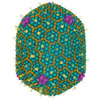+ Open data
Open data
- Basic information
Basic information
| Entry |  | |||||||||
|---|---|---|---|---|---|---|---|---|---|---|
| Title | The expanded head structure of phage T4 | |||||||||
 Map data Map data | ||||||||||
 Sample Sample |
| |||||||||
| Function / homology |  Function and homology information Function and homology information | |||||||||
| Biological species |   Bacteriophage T4 (virus) / Bacteriophage T4 (virus) /   Escherichia virus T4 Escherichia virus T4 | |||||||||
| Method |  single particle reconstruction / single particle reconstruction /  cryo EM / Resolution: 3.4 Å cryo EM / Resolution: 3.4 Å | |||||||||
 Authors Authors | Fang Q / Tang W / Fokine A / Mahalingam M / Shao Q / Rossmann MG / Rao VB | |||||||||
| Funding support |  United States, 2 items United States, 2 items
| |||||||||
 Citation Citation |  Journal: Proc Natl Acad Sci U S A / Year: 2022 Journal: Proc Natl Acad Sci U S A / Year: 2022Title: Structures of a large prolate virus capsid in unexpanded and expanded states generate insights into the icosahedral virus assembly. Authors: Qianglin Fang / Wei-Chun Tang / Andrei Fokine / Marthandan Mahalingam / Qianqian Shao / Michael G Rossmann / Venigalla B Rao /   Abstract: Many icosahedral viruses assemble proteinaceous precursors called proheads or procapsids. Proheads are metastable structures that undergo a profound structural transition known as expansion that ...Many icosahedral viruses assemble proteinaceous precursors called proheads or procapsids. Proheads are metastable structures that undergo a profound structural transition known as expansion that transforms an immature unexpanded head into a mature genome-packaging head. Bacteriophage T4 is a model virus, well studied genetically and biochemically, but its structure determination has been challenging because of its large size and unusually prolate-shaped, ∼1,200-Å-long and ∼860-Å-wide capsid. Here, we report the cryogenic electron microscopy (cryo-EM) structures of T4 capsid in both of its major conformational states: unexpanded at a resolution of 5.1 Å and expanded at a resolution of 3.4 Å. These are among the largest structures deposited in Protein Data Bank to date and provide insights into virus assembly, head length determination, and shell expansion. First, the structures illustrate major domain movements and ∼70% additional gain in inner capsid volume, an essential transformation to contain the entire viral genome. Second, intricate intracapsomer interactions involving a unique insertion domain dramatically change, allowing the capsid subunits to rotate and twist while the capsomers remain fastened at quasi-threefold axes. Third, high-affinity binding sites emerge for a capsid decoration protein that clamps adjacent capsomers, imparting extraordinary structural stability. Fourth, subtle conformational changes at capsomers' periphery modulate intercapsomer angles between capsomer planes that control capsid length. Finally, conformational changes were observed at the symmetry-mismatched portal vertex, which might be involved in triggering head expansion. These analyses illustrate how small changes in local capsid subunit interactions lead to profound shifts in viral capsid morphology, stability, and volume. | |||||||||
| History |
|
- Structure visualization
Structure visualization
| Supplemental images |
|---|
- Downloads & links
Downloads & links
-EMDB archive
| Map data |  emd_32109.map.gz emd_32109.map.gz | 3.1 GB |  EMDB map data format EMDB map data format | |
|---|---|---|---|---|
| Header (meta data) |  emd-32109-v30.xml emd-32109-v30.xml emd-32109.xml emd-32109.xml | 12.3 KB 12.3 KB | Display Display |  EMDB header EMDB header |
| Images |  emd_32109.png emd_32109.png | 252.5 KB | ||
| Archive directory |  http://ftp.pdbj.org/pub/emdb/structures/EMD-32109 http://ftp.pdbj.org/pub/emdb/structures/EMD-32109 ftp://ftp.pdbj.org/pub/emdb/structures/EMD-32109 ftp://ftp.pdbj.org/pub/emdb/structures/EMD-32109 | HTTPS FTP |
-Related structure data
| Related structure data |  7vs5MC  8t9rM  7vrtC M: atomic model generated by this map C: citing same article ( |
|---|---|
| Similar structure data | Similarity search - Function & homology  F&H Search F&H Search |
- Links
Links
| EMDB pages |  EMDB (EBI/PDBe) / EMDB (EBI/PDBe) /  EMDataResource EMDataResource |
|---|---|
| Related items in Molecule of the Month |
- Map
Map
| File |  Download / File: emd_32109.map.gz / Format: CCP4 / Size: 3.3 GB / Type: IMAGE STORED AS FLOATING POINT NUMBER (4 BYTES) Download / File: emd_32109.map.gz / Format: CCP4 / Size: 3.3 GB / Type: IMAGE STORED AS FLOATING POINT NUMBER (4 BYTES) | ||||||||||||||||||||
|---|---|---|---|---|---|---|---|---|---|---|---|---|---|---|---|---|---|---|---|---|---|
| Voxel size | X=Y=Z: 1.44 Å | ||||||||||||||||||||
| Density |
| ||||||||||||||||||||
| Symmetry | Space group: 1 | ||||||||||||||||||||
| Details | EMDB XML:
|
-Supplemental data
- Sample components
Sample components
-Entire : Escherichia virus T4
| Entire | Name:   Escherichia virus T4 Escherichia virus T4 |
|---|---|
| Components |
|
-Supramolecule #1: Escherichia virus T4
| Supramolecule | Name: Escherichia virus T4 / type: virus / ID: 1 / Parent: 0 / Macromolecule list: all / NCBI-ID: 10665 / Sci species name: Escherichia virus T4 / Virus type: VIRION / Virus isolate: STRAIN / Virus enveloped: No / Virus empty: Yes |
|---|---|
| Host (natural) | Organism:   Escherichia coli (E. coli) Escherichia coli (E. coli) |
-Macromolecule #1: Major capsid protein
| Macromolecule | Name: Major capsid protein / type: protein_or_peptide / ID: 1 / Number of copies: 186 / Enantiomer: LEVO |
|---|---|
| Source (natural) | Organism:   Bacteriophage T4 (virus) Bacteriophage T4 (virus) |
| Molecular weight | Theoretical: 56.074242 KDa |
| Sequence | String: MTIKTKAELL NKWKPLLEGE GLPEIANSKQ AIIAKIFENQ EKDFQTAPEY KDEKIAQAFG SFLTEAEIGG DHGYNATNIA AGQTSGAVT QIGPAVMGMV RRAIPNLIAF DICGVQPMNS PTGQVFALRA VYGKDPVAAG AKEAFHPMYG PDAMFSGQGA A KKFPALAA ...String: MTIKTKAELL NKWKPLLEGE GLPEIANSKQ AIIAKIFENQ EKDFQTAPEY KDEKIAQAFG SFLTEAEIGG DHGYNATNIA AGQTSGAVT QIGPAVMGMV RRAIPNLIAF DICGVQPMNS PTGQVFALRA VYGKDPVAAG AKEAFHPMYG PDAMFSGQGA A KKFPALAA STQTTVGDIY THFFQETGTV YLQASVQVTI DAGATDAAKL DAEIKKQMEA GALVEIAEGM ATSIAELQEG FN GSTDNPW NEMGFRIDKQ VIEAKSRQLK AAYSIELAQD LRAVHGMDAD AELSGILATE IMLEINREVV DWINYSAQVG KSG MTLTPG SKAGVFDFQD PIDIRGARWA GESFKALLFQ IDKEAVEIAR QTGRGEGNFI IASRNVVNVL ASVDTGISYA AQGL ATGFS TDTTKSVFAG VLGGKYRVYI DQYAKQDYFT VGYKGPNEMD AGIYYAPYVA LTPLRGSDPK NFQPVMGFKT RYGIG INPF AESAAQAPAS RIQSGMPSIL NSLGKNAYFR RVYVKGI |
-Macromolecule #2: Capsid vertex protein
| Macromolecule | Name: Capsid vertex protein / type: protein_or_peptide / ID: 2 / Number of copies: 11 / Enantiomer: LEVO |
|---|---|
| Source (natural) | Organism:   Bacteriophage T4 (virus) Bacteriophage T4 (virus) |
| Molecular weight | Theoretical: 47.039023 KDa |
| Sequence | String: MAKINELLRE STTTNSNSIG RPNLVALTRA TTKLIYSDIV ATQRTNQPVA AFYGIKYLNP DNEFTFKTGA TYAGEAGYVD REQITELTE ESKLTLNKGD LFKYNNIVYK VLEDTPFATI EESDLELALQ IAIVLLKVRL FSDAASTSKF ESSDSEIADA R FQINKWQT ...String: MAKINELLRE STTTNSNSIG RPNLVALTRA TTKLIYSDIV ATQRTNQPVA AFYGIKYLNP DNEFTFKTGA TYAGEAGYVD REQITELTE ESKLTLNKGD LFKYNNIVYK VLEDTPFATI EESDLELALQ IAIVLLKVRL FSDAASTSKF ESSDSEIADA R FQINKWQT AVKSRKLKTG ITVELAQDLE ANGFDAPNFL EDLLATEMAD EINKDILQSL ITVSKRYKVT GITDSGFIDL SY ASAPEAG RSLYRMVCEM VSHIQKESTY TATFCVASAR AAAILAASGW LKHKPEDDKY LSQNAYGFLA NGLPLYCDTN SPL DYVIVG VVENIGEKEI VGSIFYAPYT EGLDLDDPEH VGAFKVVVDP ESLQPSIGLL VRYALSANPY TVAKDEKEAR IIDG GDMDK MAGRSDLSVL LGVKLPKIII DE |
-Macromolecule #3: Small outer capsid protein
| Macromolecule | Name: Small outer capsid protein / type: protein_or_peptide / ID: 3 / Number of copies: 172 / Enantiomer: LEVO |
|---|---|
| Source (natural) | Organism:   Bacteriophage T4 (virus) Bacteriophage T4 (virus) |
| Molecular weight | Theoretical: 9.085095 KDa |
| Sequence | String: MASARGYVNI KTFEQKLDGN KKIEGKEVSV AFPLYSDVHK ISGAHYQTFP SEKAAYSTVY EENQRTEWIA ANEDLWKVTG |
-Experimental details
-Structure determination
| Method |  cryo EM cryo EM |
|---|---|
 Processing Processing |  single particle reconstruction single particle reconstruction |
| Aggregation state | particle |
- Sample preparation
Sample preparation
| Buffer | pH: 7.5 |
|---|---|
| Vitrification | Cryogen name: NITROGEN / Instrument: GATAN CRYOPLUNGE 3 |
- Electron microscopy
Electron microscopy
| Microscope | FEI TITAN KRIOS |
|---|---|
| Electron beam | Acceleration voltage: 300 kV / Electron source:  FIELD EMISSION GUN FIELD EMISSION GUN |
| Electron optics | Illumination mode: FLOOD BEAM / Imaging mode: BRIGHT FIELD Bright-field microscopy Bright-field microscopy |
| Image recording | Film or detector model: GATAN K2 SUMMIT (4k x 4k) / Average electron dose: 23.1 e/Å2 |
| Experimental equipment |  Model: Titan Krios / Image courtesy: FEI Company |
- Image processing
Image processing
| Initial angle assignment | Type: PROJECTION MATCHING |
|---|---|
| Final angle assignment | Type: PROJECTION MATCHING |
| Final reconstruction | Applied symmetry - Point group: C5 (5 fold cyclic ) / Resolution.type: BY AUTHOR / Resolution: 3.4 Å / Resolution method: FSC 0.143 CUT-OFF / Number images used: 53608 ) / Resolution.type: BY AUTHOR / Resolution: 3.4 Å / Resolution method: FSC 0.143 CUT-OFF / Number images used: 53608 |
 Movie
Movie Controller
Controller






